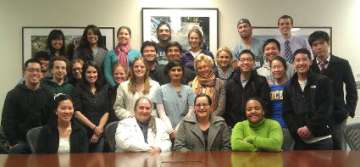SRHC Courses
SRHC Course Description & Requirements
David Geffen School of Medicine at UCLA students at all levels of their medical education can be involved in the homeless clinics. By participating, students receive course credit towards their medical degree and gain firsthand experience in community-based clinical care.
Please note: Both the Selective & Elective Courses are longitudinal experiences.

SRHC Selective and Elective Students
For MS1 and MS2:
Early Authentic Clinical Experience (EACE): MS1 will be assigned to SRHC as their EACE site, cap 18-20
Period of Participation: throughout the MS1 year, 12 clinics on specific dates to be determined by DGSOM calendar.
Requirements:
- Attend the Orientation Session
- Attend 12 clinics, scheduled on set dates, usually 1 or 2 days per month from October-May
- Attend at least 3 didactic lectures on topics of homeless medicine including: Introduction to Homelessness Causes and Solutions; Dermatologic Conditions in People Experiencing Homelessness; Mental Health Issues in People Experiencing Homelessness; Case Management for Homeless Populations; Wound and Footcare for People on the Streets; Musculoskeletal Skills Workshop for Homeless Medicine
- Fulfill all general EACE requirements
SRHC Selective SEL631: for MS1 & MS2, capacity 16-20
Period of Participation: longitudinal to be completed in either 1st or 2nd year of medical school.
Requirements:
- Attend the Orientation Session
- Attend 8 clinics of the student’s choice
- Attend at least 3 didactic lectures on topics of homeless medicine, including Introduction to Homelessness
- Attendance at the mid-year (Jan) and end-of-year (May) reflection sessions
- All requirements must be completed before moving onto the next academic year. Fulfills requirement for one Selective in either the 1st or 2nd year
- MS2 SRHC Chiefs register for this Selective (even if you already fulfilled the Selective requirement in year 1)
Electives for MS3 SRHC Chiefs & MS4 non-Chiefs
FP253.03
(One week of 200-level credit)
Period of Participation: longitudinal throughout the academic year
Requirements:
- Attend the Orientation Session
- Attend 8 clinics of the student’s choice (must complete at least half of the clinics before the end of January)
- Attendance at the mid-year (Jan) and end-of-year (May) reflection sessions
- MS4: All requirements must be completed by May of graduation year.
- May fulfill Primary Care College clinic requirement.
Discovery (Year 3) Student Run Homeless Clinics Service Leadership and Research Opportunities
Capacity:3 students
Chiefs
FP150.01 & FP250.03 The Student Chief
(Must register for both. Will get one week of 100-level credit and one week of 200-level credit)
Period of Participation: longitudinal
Requirements:
- Attend the Orientation Session
- Attend 8 clinics of the student’s choice (must complete at least half of the clinics before the end of January)
- Perform 1 educational activity at a regularly scheduled clinic to guide/teach MS1/2 on performing an H&P, including assessment and plan, assist them in preparing their presentation for the attending physician
- Design a teaching module on a topic of homeless medicine for our on-line curriculum in coordination with the SRHC Program Director
OR:
- Perform a longitudinal QI/research project on homeless medicine, to be presented at the Society of Student Run Free Clinics national conference or other venue including Senior Research Day. This project may be started in the 3rd yr. Project proposals must be approved by the SRHC Program Director
- Manage various assigned tasks of the SRHC clinics, including: planning clinic budget and purchases, managing patient records, organizing clinic layout and patient flow, procuring medical supplies and medication stocks, scheduling clinics, recruiting volunteers and attendings, providing immunizations, and coordinating the health care team under the supervision of the attending faculty
- All requirements must be completed by May of graduation year